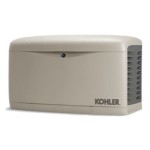Whole House Kohler Generators
How to Size Your Standby Generator System
Selecting your whole house generator is easy as long as you stay away from online wattage calculators.
1. Every Home and Every Appliance is Unique.
The calculators estimate the wattage for each appliance. The reality is that your calculation can vary significantly depending on the energy efficiency of each appliance.
2. The Power is Constantly Fluctuating.
The wattage varies from day to night. It changes dramatically when the refrigerator starts or the central air conditioner kicks on. In reality, it’s a rare occurrence when every appliance runs
simultaneously.
3. The Small Stuff is Somewhat Insignificant.
It really doesn’t make a big difference how many 60-watt light bulbs you select. You need to focus your concern on a select number of high-powered appliances, like central air conditioners, heat
pumps and well pumps.
Basically, there are two ways that you can size your generator:
1. Buy What You Can Afford
If you don’t want to spend a fortune on a 45-kilowatt version (which you may not even need), get the 20-kilowatt version instead (which is load shedding and still will power your entire home.
In most instances, the 20-kilowatt model will power an entire house without any problems. We can design a system to fit your budget and customize which circuits to back up and energize
in your home.
2. Hire a Licensed Electrician
If you are considering a 35- or 45-kilowatt model, you’ll need our professional help. Otherwise, you might end up buying a system that produces more electricity than you actually need.
The only completely accurate way is to have one of our electricians apply an amp meter to the circuits or appliances that are being chosen to operate under emergency backup power.
GETTING STARTED
One thing to keep in mind: installing a generator is not a DIY project. Your standby generator is connected to your home’s electrical and natural gas or liquid propane systems, making it a job for experienced professionals.
Because of this, your generator installation process begins with a home visit or virtual site visit with Pendl Electric. We are a KOHLER dealer and Authorized Service Center. We will help you choose the perfect size generator, the right fuel source, and the best installation locations for your generator and automatic transfer switch.









